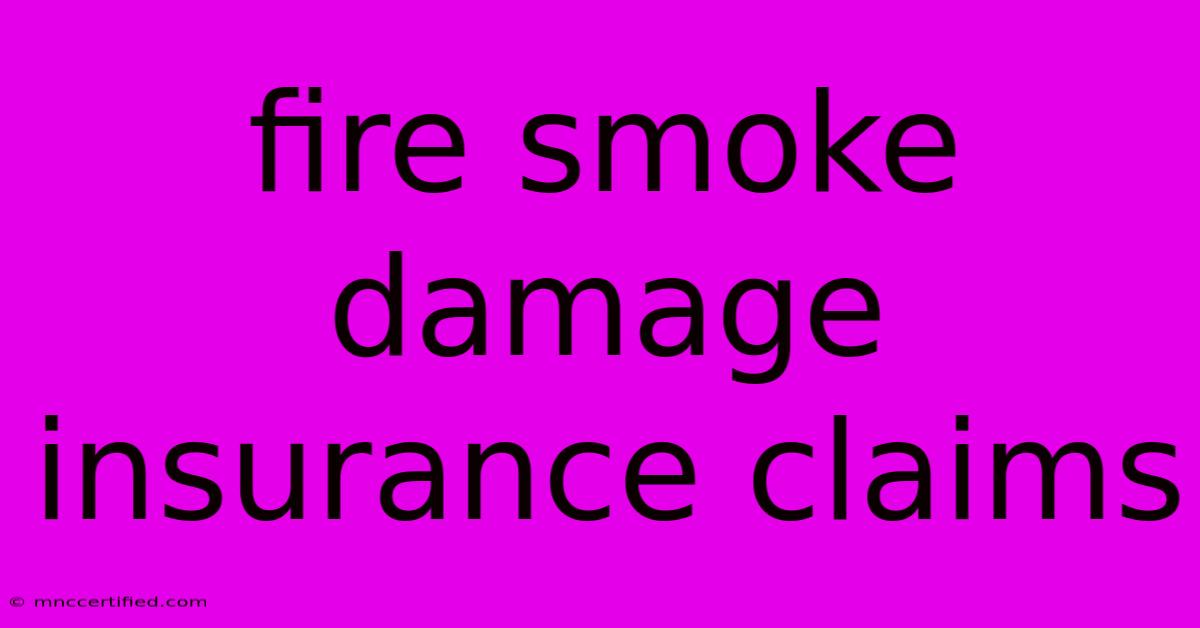Fire Smoke Damage Insurance Claims

Table of Contents
Navigating Fire and Smoke Damage Insurance Claims: A Comprehensive Guide
Dealing with a fire is traumatic enough, but the aftermath often involves the complex process of filing an insurance claim for fire and smoke damage. This guide will walk you through the essential steps, helping you navigate this challenging period and secure the compensation you deserve.
Understanding Your Coverage
Before the fire, review your homeowner's or renter's insurance policy thoroughly. Pay close attention to the sections on fire damage, smoke damage, and additional living expenses (ALE). Knowing your policy's specifics – including coverage limits, deductibles, and exclusions – is crucial for a smooth claims process. Common exclusions might include damage caused by neglect or pre-existing conditions. Document everything, including policy numbers and contact information.
Key Coverage Areas:
- Direct Fire Damage: This covers damage directly caused by the fire itself, such as structural damage, burnt furniture, and destroyed belongings.
- Smoke Damage: This covers damage caused by smoke, soot, and related residues, including cleaning and restoration costs. This often extends beyond visibly affected areas.
- Additional Living Expenses (ALE): If your home becomes uninhabitable due to the fire, ALE coverage can reimburse you for temporary housing, meals, and other essential expenses while repairs are underway.
- Personal Property: This covers the replacement or repair of your personal belongings damaged or destroyed in the fire. Consider creating a home inventory with photos and receipts for quicker processing.
Immediate Steps After a Fire:
Safety First! Prioritize the safety of yourself and your family. If the fire is still active, evacuate immediately and call emergency services. Once the fire is extinguished and it's safe to return:
- Contact your insurance company immediately. Report the fire and initiate the claims process. Provide them with all necessary information.
- Document the damage: Take detailed photos and videos of the damage to your property and belongings from multiple angles. This visual evidence is critical for supporting your claim.
- Secure your property: Take steps to prevent further damage, such as boarding up broken windows or covering damaged areas to prevent water damage.
- Keep records of all communication: Maintain records of all phone calls, emails, and correspondence with your insurance adjuster.
- Keep receipts: Keep receipts for all expenses related to the fire, including temporary housing, cleaning supplies, and repairs. These are essential for reimbursement under ALE and other relevant coverages.
Working with Your Insurance Adjuster:
Your insurance company will assign an adjuster to assess the damage and determine the amount of compensation.
- Cooperation is key: Be cooperative and responsive to your adjuster's requests. Provide them with all necessary documentation and access to your property.
- Understand the claims process: Familiarize yourself with the steps involved, including inspections, appraisals, and negotiations.
- Negotiate fairly: Don't be afraid to negotiate if you believe the offered settlement is insufficient. Gather evidence to support your claim.
- Consider professional assistance: If the claim is complex or you're struggling to navigate the process, consider consulting with a public adjuster who specializes in insurance claims.
Common Challenges and How to Address Them:
- Underestimating the damage: Thoroughly document all damages, including hidden smoke damage that might not be immediately visible.
- Delayed payments: Follow up regularly with your adjuster to ensure your claim is processed efficiently.
- Disputes over coverage: Review your policy carefully and be prepared to negotiate if necessary. Consult with a lawyer if you can't resolve the dispute.
Preventing Future Fire Damage:
Taking preventative measures can significantly reduce the risk of future fire damage. This includes:
- Regular maintenance of appliances and electrical systems: Check for faulty wiring, overloaded circuits, and malfunctioning appliances.
- Smoke detector installation and maintenance: Ensure you have working smoke detectors on every level of your home.
- Fire extinguisher placement: Keep fire extinguishers readily accessible and know how to use them.
- Safe storage of flammable materials: Store flammable liquids and materials properly.
Filing a fire and smoke damage insurance claim can be a stressful experience, but by understanding your coverage, documenting the damage thoroughly, and working proactively with your insurance company, you can significantly improve your chances of a successful outcome. Remember, preparation and proactive communication are your best allies.

Thank you for visiting our website wich cover about Fire Smoke Damage Insurance Claims. We hope the information provided has been useful to you. Feel free to contact us if you have any questions or need further assistance. See you next time and dont miss to bookmark.
Featured Posts
-
United Home Insurance Paragould Ar
Nov 16, 2024
-
Continental Insurance Phone Number
Nov 16, 2024
-
Portugal Victory Ronaldos Penalty And Kick
Nov 16, 2024
-
Rfk Jrs Health Policy Claims Fact Checked
Nov 16, 2024
-
Acupuncture Cost Without Insurance
Nov 16, 2024